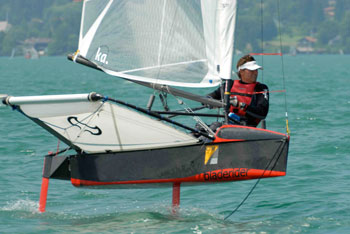The Moth, Flying
by Fishermen’s Voice Staff

Moths reach high speeds by riding up on horizontal foils on the center dagger board and rudder. Foils generate lift enough in this case to bring the hull out of the water. The rudder foil left and the dagger board foil (center) dramatically reduce drag at speed. IYRS Photo
Doing more with less has been a naval design mantra in recent years. This has been true for both power and sail vessels from very high speed US Navy torpedos to small sail boats that skim along the surface on tiny amounts of wetted surface.
A Moth class sail boat built by students at the International Yacht Restoration School (IYRS) in Newport Rhode Island is an example of the extreme end of the less is more school of naval architecture.
The moth as a class has been around for 100 years, but what the IYRS began building in 2010 was futuristic compared to even it’s most recent ancestry. As with other boat classes there were design rules to consider in the design process. Earlier models were skimming dishes which by the 1990’s were trimming down to near 12 inches in width.
IYRS’s Henry Elliot designed the the school’s new moth which was delivered to Sail Newport in 2013, a public sailing program in Newport, Rhode Island. That IYRS Moth has a 12’ long narrow center hull with wings on both sides that are decked with netting. The outer edges of the wings serve as operator positions for countering heeling moment. This Moth has reached speeds of 30 knots. These speeds are not the only thing new about this Moth. The IYRS boat is built entirely of carbon fiber composites. Light and strong, carbon fiber has uses beyond the boatbuilding in industries as varied as automobiles, furniture and wind generators.
Elliot said Australians had been experimenting with Moths using foils, including foils on the Moth’s dagger boards and a lift foil on the rudder. Foils are thin, narrow pieces that ride in the water and generate lift enough in this case to bring the hull out of the water. The boat then rides on the small horizontal surface areas of the foils.
Sailing this new Moth, and some of the other new high speed sailing vessels, requires a new set of skills. Sailing one of these vessels is far more complicated than conventional sailing vessels, a fact that is multiplied at high speeds.

Deck area. The foil center board resting diagonally across white deck webbing material. IYRS Photo
The IYRS took on the project as a composites/materials project for the students. The first year they built the plugs, made tools, tubes used to fabricate the boat and some of the foil blades. The second year they built the hulls, rudder blades, and rudder ganters. Assembly had it own set of complicated processes.
Elliot said the school is focused on composite processes and materials for a range of applications and industries that can offer students opportunities for good paying jobs.
The Moth’s speed places it among a few of the other high speed vessels like the 49’er. The 49'er is an Australian boat with a main sail and large spinnaker. Sailors ride far outboard on long wings to counter heeling. Operators are also suspended from a trapeze attached to the top of the mast, which enables them to reach greater counter weight distances from the centerline of the narrow hull.
The new Moth design has minimized vessel weight, maximized strength to weight and minimized drag when riding on the foils. These three key components for reducing energy demand and increasing performance are leading the drive for efficiency. Practical commercial applications will move forward at a slower but necessary pace.
Composites will continue to evolve in the construction of boats and other areas where reducing energy inputs are becoming increasingly important.
